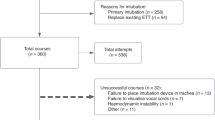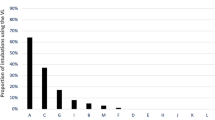Abstract
Objective
To determine the relationship between number of attempts and adverse events during neonatal intubation.
Study design
A retrospective study of prospectively collected data of intubations in the delivery room and NICU from the National Emergency Airway Registry for Neonates (NEAR4NEOS) in 17 academic centers from 1/2016 to 12/2019. We examined the association between tracheal intubation attempts [1, 2, and ≥3 (multiple attempts)] and clinical adverse outcomes (any tracheal intubation associated events (TIAE), severe TIAE, and severe oxygen desaturation).
Results
Of 7708 intubations, 1474 (22%) required ≥3 attempts. Patient, provider, and practice factors were associated with higher TI attempts. Increasing intubation attempts was independently associated with a higher risk for TIAE. The adjusted odds ratio for TIAE and severe oxygen desaturation were significantly higher in TIs with 2 and ≥3 attempts than with one attempt.
Conclusion
The risk of adverse safety events during intubation increases with the number of intubation attempts.
This is a preview of subscription content, access via your institution
Access options
Subscribe to this journal
Receive 12 print issues and online access
$259.00 per year
only $21.58 per issue
Buy this article
- Purchase on Springer Link
- Instant access to full article PDF
Prices may be subject to local taxes which are calculated during checkout


Similar content being viewed by others
References
Foglia EE, Ades A, Sawyer T, Glass KM, Singh N, Jung P, et al. Neonatal intubation practice and outcomes: an international registry study. Pediatrics. 2019;143:e20180902.
Parker MM, Nuthall G, Brown C 3rd, Biagas K, Napolitano N, Polikoff LA, et al. Relationship between adverse tracheal intubation associated events and PICU outcomes. Pediatr Crit Care Med. 2017;18:310–8.
Hatch LD, Grubb PH, Lea AS, Walsh WF, Markham MH, Whitney GM, et al. Endotracheal intubation in neonates: a prospective study of adverse safety events in 162 infants. J Pediatr. 2016;168:62–6.e6.
Sawyer T, Foglia E, Hatch LD, Moussa A, Ades A, Johnston L, et al. Improving neonatal intubation safety: a journey of a thousand miles. J Neonatal Perinat Med. 2017;10:125–31.
Foglia EE, Ades A, Napolitano N, Leffelman J, Nadkarni V, Nishisaki A. Factors associated with adverse events during tracheal intubation in the NICU. Neonatology 2015;108:23–9.
Sawyer T, Foglia EE, Ades A, Moussa A, Napolitano N, Glass K, et al. Incidence, impact and indicators of difficult intubations in the neonatal intensive care unit: a report from the National Emergency Airway Registry for Neonates. Arch Dis Child Fetal Neonatal Ed. 2019;104:F461–F6.
Friesen RH, Honda AT, Thieme RE. Changes in anterior fontanel pressure in preterm neonates during tracheal intubation. Anesth Analg. 1987;66:874–8.
Marshall TA, Deeder R, Pai S, Berkowitz GP, Austin TL. Physiologic changes associated with endotracheal intubation in preterm infants. Crit Care Med. 1984;12:501–3.
Kaplan JD, Schuster DP. Physiologic consequences of tracheal intubation. Clin Chest Med. 1991;12:425–32.
Millar C, Bissonnette B. Awake intubation increases intracranial pressure without affecting cerebral blood flow velocity in infants. Can J Anaesth. 1994;41:281–7.
Galvez JA, Acquah S, Ahumada L, Cai L, Polanski M, Wu L, et al. Hypoxemia, bradycardia, and multiple laryngoscopy attempts during anesthetic induction in infants: a single-center, retrospective study. Anesthesiology 2019;131:830–9.
Hasegawa K, Shigemitsu K, Hagiwara Y, Chiba T, Watase H, Brown CA 3rd, et al. Association between repeated intubation attempts and adverse events in emergency departments: an analysis of a multicenter prospective observational study. Ann Emerg Med. 2012;60:749–54 e2.
Graciano AL, Tamburro R, Thompson AE, Fiadjoe J, Nadkarni VM, Nishisaki A. Incidence and associated factors of difficult tracheal intubations in pediatric ICUs: a report from National Emergency Airway Registry for Children: NEAR4KIDS. Intensive Care Med. 2014;40:1659–69.
Sakles JC, Chiu S, Mosier J, Walker C, Stolz U. The importance of first pass success when performing orotracheal intubation in the emergency department. Acad Emerg Med. 2013;20:71–8.
Mort TC. Emergency tracheal intubation: complications associated with repeated laryngoscopic attempts. Anesth Analg. 2004;99:607–13. table of contents
Long E, Sabato S, Babl FE. Endotracheal intubation in the pediatric emergency department. Paediatr Anaesth. 2014;24:1204–11.
Choi HJ, Je SM, Kim JH, Kim E. The factors associated with successful paediatric endotracheal intubation on the first attempt in emergency departments: a 13-emergency-department registry study. Resuscitation 2012;83:1363–8.
Fiadjoe JENA, Jagannathan N, Hunyady AI, Greenberg RS, Reynolds PI, Matuszczak ME, Rehman MA, Polaner DM, Szmuk P, Nadkarni VM, McGowan FX Jr, Litman RS, Kovatsis PG. Airway management complications in children with difficult tracheal intubation from the Pediatric Difficult Intubation (PeDI) registry: a prospective cohort analysis. Lancet. Respir Med. 2015;4:37–48.
Lee JH, Turner DA, Kamat P, Nett S, Shults J, Nadkarni VM, et al. The number of tracheal intubation attempts matters! A prospective multi-institutional pediatric observational study. BMC Pediatr. 2016;16:58.
Wallenstein MB, Birnie KL, Arain YH, Yang W, Yamada NK, Huffman LC, et al. Failed endotracheal intubation and adverse outcomes among extremely low birth weight infants. J Perinatol. 2016;36:112–5.
Sauer CW, Kong JY, Vaucher YE, Finer N, Proudfoot JA, Boutin MA, et al. Intubation attempts increase the risk for severe intraventricular hemorrhage in preterm infants-a retrospective cohort study. J Pediatr. 2016;177:108–13.
Carroll CL, Spinella PC, Corsi JM, Stoltz P, Zucker AR. Emergent endotracheal intubations in children: be careful if it’s late when you intubate. Pediatr Crit Care Med. 2010;11:343–8.
Ehrlich PF, Seidman PS, Atallah O, Haque A, Helmkamp J. Endotracheal intubations in rural pediatric trauma patients. J Pediatr Surg. 2004;39:1376–80.
Disma N, Virag K, Riva T, Kaufmann J, Engelhardt T, Habre W. Difficult tracheal intubation in neonates and infants. NEonate and Children audiT of Anaesthesia pRactice IN Europe (NECTARINE): a prospective European multicentre observational study. Br J Anaesth. 2021;126:1173–81.
Glenn T, Sudhakar S, Markowski A, Malay S, Hibbs AM. Patient characteristics associated with complications during neonatal intubations. Pediatr Pulmonol. 2021;56:2576–82.
Lingappan K, Arnold JL, Fernandes CJ, Pammi M. Videolaryngoscopy versus direct laryngoscopy for tracheal intubation in neonates. Cochrane Database Syst Rev. 2018;6:CD009975.
Hypes CD, Stolz U, Sakles JC, Joshi RR, Natt B, Malo J, et al. Video laryngoscopy improves odds of first-attempt success at intubation in the intensive care unit. a propensity-matched analysis. Ann Am Thorac Soc. 2016;13:382–90.
Ozawa Y, Ades A, Foglia EE, DeMeo S, Barry J, Sawyer T, et al. Premedication with neuromuscular blockade and sedation during neonatal intubation is associated with fewer adverse events. J Perinatol. 2019;39:848–56.
Johnston L, Sawyer T, Ades A, Moussa A, Zenge J, Jung P, et al. Impact of physician training level on neonatal tracheal intubation success rates and adverse events: a report from national emergency airway registry for neonates (NEAR4NEOS). Neonatology 2021;118:434–42.
Le CN, Garey DM, Leone TA, Goodmar JK, Rich W, Finer NN. Impact of premedication on neonatal intubations by pediatric and neonatal trainees. J Perinatol. 2014;34:458–60.
Leone TA, Rich W, Finer NN. Neonatal intubation: success of pediatric trainees. J Pediatr. 2005;146:638–41.
O’Shea JE, Thio M, Kamlin CO, McGrory L, Wong C, John J, et al. Videolaryngoscopy to Teach Neonatal Intubation: A Randomized Trial. Pediatrics 2015;136:912–9.
Pouppirt NR, Nassar R, Napolitano N, Nawab U, Nishisaki A, Nadkarni V, et al. Association between video laryngoscopy and adverse tracheal intubation-associated events in the neonatal intensive care unit. J Pediatr. 2018;201:281–4.e1.
Funding
This research was supported by NICHD R21 HD089151. Akira Nishisaki was supported by NICHD R21 HD089151 and AHRQ R18HS024511. EEF was supported by NICHD K23HD084727 and is a consultant for Medtronic. Natalie Napolitano was supported by NICHD R21 HD 089151 and AHRQ R18HS024511 and have research and/or consulting relationships with Drager, Actuated Medical, Smiths Medical, and VERO-Biotech. DGT is supported by a National Health and Medical Research Council (Australia) Investigator (Grant ID 2008212) and the Victorian Government Operational Infrastructure Support Program (Melbourne, Australia).
Author information
Authors and Affiliations
Consortia
Contributions
NS conceptualized and designed the study, analyzed the data, drafted the initial manuscript, and reviewed and revised the manuscript. All authors except JS coordinated and supervised data collection. JS and AN performed statistical analyses. All authors participated in data collection in their respective sites, interpreted the data and critically reviewed and revised the manuscript for important intellectual content. All authors approved the final manuscript as submitted and agree to be accountable for all aspects of the work.
Corresponding author
Ethics declarations
Competing interests
The authors have no conflicts of interest to declare. JB and NS are the site principal investigator for aerosolized surfactant clinical trial phase 2b sponsored by Aerogen.
Additional information
Publisher’s note Springer Nature remains neutral with regard to jurisdictional claims in published maps and institutional affiliations.
Supplementary information
Rights and permissions
Springer Nature or its licensor holds exclusive rights to this article under a publishing agreement with the author(s) or other rightsholder(s); author self-archiving of the accepted manuscript version of this article is solely governed by the terms of such publishing agreement and applicable law.
About this article
Cite this article
Singh, N., Sawyer, T., Johnston, L.C. et al. Impact of multiple intubation attempts on adverse tracheal intubation associated events in neonates: a report from the NEAR4NEOS. J Perinatol 42, 1221–1227 (2022). https://doi.org/10.1038/s41372-022-01484-5
Received:
Revised:
Accepted:
Published:
Issue Date:
DOI: https://doi.org/10.1038/s41372-022-01484-5
This article is cited by
-
Retrospective consent for neonatal intubations. Going with the flow?
Journal of Perinatology (2023)
-
I-gel Plus acts as a superior conduit for fiberoptic intubation than standard i-gel
Scientific Reports (2023)



